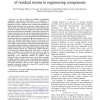Free Online Productivity Tools
i2Speak
i2Symbol
i2OCR
iTex2Img
iWeb2Print
iWeb2Shot
i2Type
iPdf2Split
iPdf2Merge
i2Bopomofo
i2Arabic
i2Style
i2Image
i2PDF
iLatex2Rtf
Sci2ools
90
Voted
WCE
2007
2007
High energy white beam x-ray diffraction studies of residual strains in engineering components
— In order to predict the durability of engineering components and improve performance, it is mandatory to understand residual stresses. The last decade has witnessed a significant increase of residual stress evaluation using diffraction of penetrating radiation, such as neutrons or high energy X-rays. They provide a powerful non-destructive method for determining the level of residual stresses in engineering components through precise characterisation of interplanar crystal lattice spacing. The unique non-destructive nature of these measurement techniques is particularly beneficial in the context of engineering design, since it allows the evaluation of a variety of structural and deformational parameters inside real components without material removal, or at worst with minimal interference. However, while most real engineering components have complex shape and are often large in size, leading to measurement and interpretation difficulties, since experimental facilities usually have ...
| Added | 07 Nov 2010 |
| Updated | 07 Nov 2010 |
| Type | Conference |
| Year | 2007 |
| Where | WCE |
| Authors | Shu Yan Zhang, Willem J. J. Vorster, Tea-Sung Jun, Xu Song, Mina Golshan, David Laundy, Michael J. Walsh, Alexander M. Korsunsky |
Comments (0)

